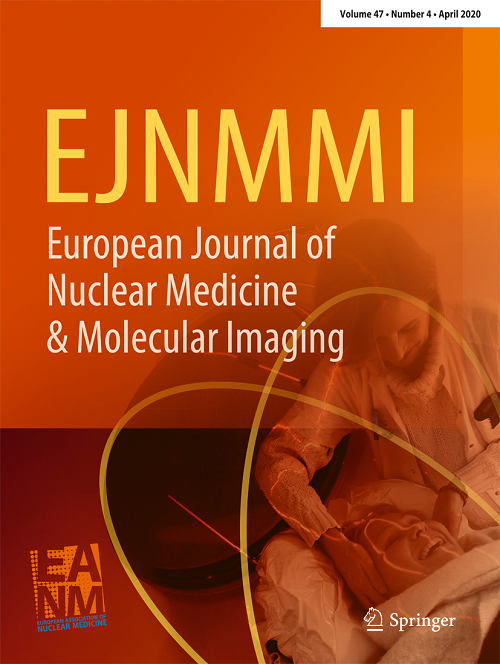The utility of 68Ga-pentixafor PET/CT in superselective adrenal artery embolization(SAAE) for treating aldosterone adenomas.
IF 7.6
1区 医学
Q1 RADIOLOGY, NUCLEAR MEDICINE & MEDICAL IMAGING
European Journal of Nuclear Medicine and Molecular Imaging
Pub Date : 2025-08-15
DOI:10.1007/s00259-025-07465-y
引用次数: 0
Abstract
PURPOSE Expression of CXC chemokine receptor 4 (CXCR4) has proved to be a valuable tool for guiding the diagnosis and treatment of aldosterone-producing adenoma (APA). In this study, we evaluated whether CXCR4 imaging with 68Ga-pentixafor PET/CT shows significant changes after superselective adrenal artery embolization (SAAE). METHODS We prospectively recruited 25 patients with clinically diagnosed APA. All patients were examined with 68Ga-pentixafor PET/CT and adrenal venous blood sampling (AVS) before and after SAAE. PET/CT showed that the tracer uptake of unilateral nodular adrenal gland was higher than that of normal adrenal tissue. AVS showed that the dominant secretory side was consistent with that on PET/CT. All patients were successfully treated with SAAE. Clinical follow-up was carried out according to primary aldosteronism surgical outcome (PASO) criteria, and included monitoring of drug type, blood pressure, serum potassium, and aldosterone/renin ratio to evaluate surgical effect. Post operation 68Ga-pentixafor PET/CT and the maximum standardized uptake value (SUVmax) were used to observe the uptake of adrenal lesions after SAAE. RESULTS Among the 25 APA patients who successfully underwent SAAE, 14 were men and the average age was 51.88 ± 8.89 years. The consistency between AVS and 68Ga-pentixafor PET/CT reaches 100%. Before operation, the SUVmax of the diseased side (16.79 ± 2.51, n = 25) was significantly higher than that of the non-diseased side (4.56 ± 0.57, P < 0.01). According to PASO criteria, 13 of 25 patients achieved complete clinical remission, 9 achieved partial remission and the treatment was ineffective for three patients. 19 cases achieved biochemical complete remission and 3 cases achieved partial remission. Following the treatment, 22 patients showed complete or partial remission. The 68Ga-pentixafor SUVmax of the diseased side decreased significantly (16.75 ± 2.54 vs. 4.37 ± 1.52, n = 22, P < 0.001). For the patients who ineffective to the treatment, the SUVmax did not change (17.07 ± 2.72 vs. 16.17 ± 2.72, n = 3, P = 0.842). The 25 patients were divided into two groups according to the average value (≥ 65% and < 65%) of the decrease in SUVmax. The decrease in SUVmax correlated with a good patient prognosis under the PASO standard (P = 0.009). CONCLUSION A decrease in SUVmax is related to the prognosis. CXCR4 imaging with 68Ga-pentixafor can be used for pre- and post-SAAE evaluation in patients with APA.68ga - pentxafor PET/CT在超选择性肾上腺动脉栓塞治疗醛固酮腺瘤中的应用。
目的CXC趋化因子受体4 (CXCR4)的表达已被证明是指导醛固酮生成腺瘤(APA)诊断和治疗的有价值的工具。在本研究中,我们评估了68ga - pentxafor PET/CT在超选择性肾上腺动脉栓塞(SAAE)后CXCR4成像是否显示显著变化。方法前瞻性招募25例临床诊断为APA的患者。所有患者在SAAE前后均行68ga - pentxapet /CT和肾上腺静脉血采样(AVS)检查。PET/CT显示单侧结节肾上腺示踪剂摄取高于正常肾上腺组织。AVS显示优势分泌侧与PET/CT一致。所有患者均成功接受SAAE治疗。根据原发性醛固酮增多症手术结局(PASO)标准进行临床随访,监测药物类型、血压、血钾、醛固酮/肾素比值评价手术效果。术后采用68ga - pentxafor PET/CT及最大标准化摄取值(SUVmax)观察SAAE后肾上腺病变的摄取情况。结果25例成功行SAAE的APA患者中,男性14例,平均年龄51.88±8.89岁。AVS与68ga - pentxaat PET/CT的一致性达到100%。术前病变侧SUVmax(16.79±2.51,n = 25)明显高于非病变侧(4.56±0.57,P < 0.01)。根据PASO标准,25例患者中13例达到临床完全缓解,9例达到部分缓解,3例治疗无效。生化完全缓解19例,部分缓解3例。治疗后,22名患者出现完全或部分缓解。患病侧68Ga-pentixafor SUVmax显著降低(16.75±2.54∶4.37±1.52,n = 22, P < 0.001)。对于治疗无效的患者,SUVmax无变化(17.07±2.72∶16.17±2.72,n = 3, P = 0.842)。根据SUVmax下降的平均值(≥65%和< 65%)将25例患者分为两组。在PASO标准下,SUVmax的降低与患者预后良好相关(P = 0.009)。结论SUVmax的降低与预后有关。68ga - pentxafor CXCR4成像可用于APA患者saae前后的评估。
本文章由计算机程序翻译,如有差异,请以英文原文为准。
求助全文
约1分钟内获得全文
求助全文
来源期刊
CiteScore
15.60
自引率
9.90%
发文量
392
审稿时长
3 months
期刊介绍:
The European Journal of Nuclear Medicine and Molecular Imaging serves as a platform for the exchange of clinical and scientific information within nuclear medicine and related professions. It welcomes international submissions from professionals involved in the functional, metabolic, and molecular investigation of diseases. The journal's coverage spans physics, dosimetry, radiation biology, radiochemistry, and pharmacy, providing high-quality peer review by experts in the field. Known for highly cited and downloaded articles, it ensures global visibility for research work and is part of the EJNMMI journal family.

 求助内容:
求助内容: 应助结果提醒方式:
应助结果提醒方式:


